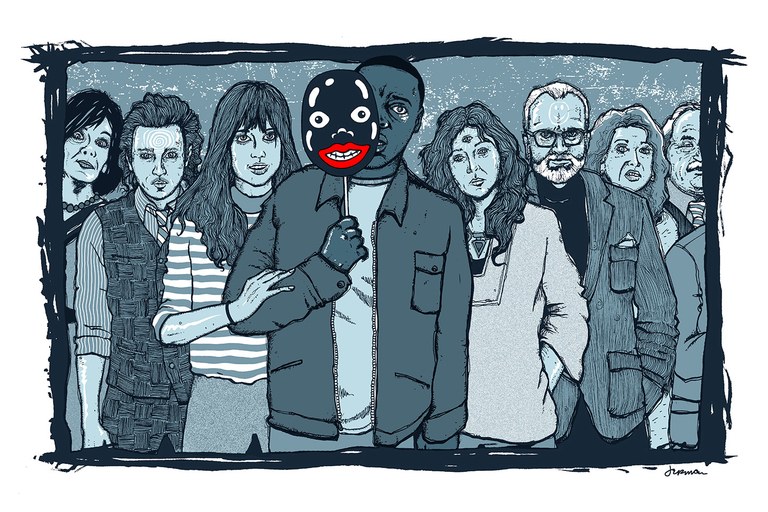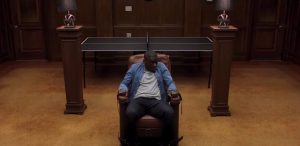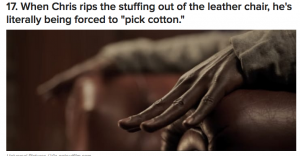When Chris is tied up in the Armitage’s basement, he pulls out the cotton stuffing from the armchair he is strapped into and uses it as an ear plug to keep him from falling under hypnosis. Initially, we connect Chris’ original trauma (when he allowed his mother to die in a hit and run while he sat at home and watched tv) to his ability to get free. We see in the many flashbacks to his mother’s death that Chris is largely paralyzed–except for a frantic clawing at the bedposts. Flash-forwarding to Chris’ restraint in the basement after being tied down at the basement by the leather binds, the hypnosis backfires, as the saving grace of being hypnotized is that it sends him back into the moment if his mother’s death, which is what forces his hands to frantically claw–this time at the leather chair, revealing the cotton underneath. In resisting the family’s hypnosis, Chris picks and stuffs cotton into his ears, a racial irony that touches on the notable role that cotton picking played in the enslavement of black people. As Chris’ arms and feet are bound, much like slaves were shackled, this imagery of literally picking cotton to drown out the noise of the oppressor subverts this historical trope and is how Chris manages to survive.
“This might be the only time where a Black man picking cotton has been a lifesaving task.”
The phrase used to describe American economy in the 1830’s and 1840’s was “cotton is king.” It became the first mass consumer commodity and its production turned millions of black human beings themselves into commodities, particularly in Southern United States.

Black slaves processing cotton on an American plantation
The connection to cotton picking gives the movie a much deeper historical and racial relevance that ties the experience of African Americans to Chris. The deeply-embedded trauma of being the descendants of slaves is inherent in all African Americans. That it is what ultimately comes to save Chris’ life is an allegory that many African Americans can appreciate as they struggle with present-day conditions. Perhaps this might be Keele’s way of suggesting that white people cannot keep African Americans trapped in their historical trauma and that it is the very fact of that trauma that will ultimately liberate descendants of this traumatic history. Thus, plugging his ears with the cotton becomes symbolic of how the memory of past enslavement becomes protection against re-enslavement.
Connections to the Readings
In tying these to a contemporary framework, Zakiyyah Iman Jackson’s “Animal: New Directions in the Theorization of Race and Posthumanism” narrates a turn in critical theory towards the animal. Her intervention and iterations of animal studies and posthumanism aim to address how the fields of animal studies and posthumanism would be altered if the work and activism of people thinking about race and racism circumscribed the boundaries between human and animals within a posthumanist framework. To that, she articulates how we risk denying people’s humanity and how by ignoring history and centuries of colonization, we risk perpetuating this notion. In other words, ignoring the histories of slavery, colonialism, and racialization and how these play into the human, re-run into the risk of replicating the same violent epistemological assumptions that feminism is supposed to work against. While the goal of posthumanism is to decentralize the human so that we get a sense of how we are all connected, it can be harmful because it ignores how colonialism and slavery never gave the chance to some groups of people to be humans themselves.
Thus to ignore colonialism, slavery, and imperialism, as white characters in the film attempt to do, would mean blinding ourselves to the heteronormativity that underpins our legal system and most other aspects of our lives. Jackson articulates that the idea to move beyond the “human” comes from a place of privilege (a luxury that only white people have because their humanity is already acknowledged due to the Eurocentric historic domination of the world) while minorities are seen as irrational (therefore less than human) and their history of slavery, colonialism, imperialism, and conquest is erased by post-humanism. In subverting the trope of cotton picking and the symbolism it serves in present-day, Keele confronts this erasure and brings to the forefront the legacy of slavery and imperialism that continue to manifest in present-day and inform the day-to-day experiences of black people in modern-day America. In teasing out this parallel, the film links the ubiquitous trauma of both past and modern-day enslavement to essentially push against the idea of a ‘postracial America.’



